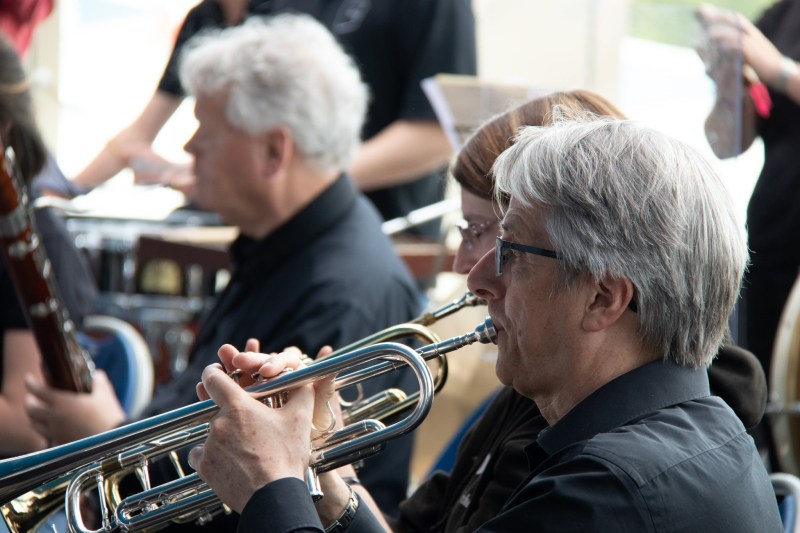Guest post – A view from the ‘cornettos’
Trumpeter Dr. Helen Julia Minors reflects on rehearsals for #ShadowOfStalin on Sunday 5th October, 2019
This rehearsal was memorable for many reasons, but most notably because I and my section were requested to come forth and project our sound even more. Now, you must know in reading this that, a) trumpets can be very loud – they aim forward not too dissimilar to a giant pea shooter with fire-charged ghetto-blaster volume, b) we are playing Shostakovich’s 10th Symphony, which calls for loud dynamics throughout (there is not a single request for a piano, quiet moment) and, c) our trumpet team are not shy about coming forward. We are normally invited to tone it down in rehearsal…I can’t think why!

So imagine our delight, shock, and, frankly, our gut-busting laughter when our conductor, Andrew, stopped us in our tracks to sing in full voice the Neapolitan song, ‘O Sole Mio’ (in the time-honoured version, ‘Just one cornetto!’), accompanied by flying arm gestures and a massive cheeky grin. Sometimes I wonder how I manage not to knock my front teeth out with my instrument as I laugh so much in our rehearsals. Obviously we the ‘cornettos’ were muttering about needing an ice cream at this point. But we got the point, we needed to accent the notes more rather than caress them as per the song.
This particular piece of Shostakovich requires us to sound angry, furious, enraged and wrathful. It is relentless and quite daunting for the orchestra. As much as I jest about us (we the trumpets) enjoying playing loudly, it is stamina-draining and can be quite sweaty! Playing quietly takes a lot of effort, but playing loudly is not about letting it all go. The madness and rage must be managed and kept in control even if we are trying to sound like team-maniac. Listening to each individual player becomes more difficult when the dynamic rises, not least because we trumpets sit in the dangers seats: slap-bang in front of the bells of the trombones. We are blasted in the ears and it’s a wonder their slides don’t thump us in the back (seriously though, we love our trombone friends and together sit as a section).

The brass section works together throughout Shostakovich’s symphonies and for a successful performance we need to breath, think and feel this music together. This goes for the whole orchestra. We feel tired in the brass after a long day’s rehearsal, but the lion’s share of the notes are coming from the strings. Their arms and fingers seem to fly so quickly I am sure we could have a new Olympic sport in the field of bow scraping. Given how virtuosic the writing is, it was delightful to hear how well this rehearsal was going, collectively.
Symphony number 10 was first performed on 17 December 1953 by the Leningrad Philharmonic Orchestra after the death of Joseph Stalin. This is important to know when we are interpreting the piece – Shostakovich was what I like to think of as an intellectual composer, in that like Edward Saïd he spoke (through music) when others could not speak or say what they wanted to. In an era of censorship, Shostakovich had lived with a suitcase packed in case he had needed a speedy escape. So how best to hide in plain sight but to incorporate into your work a musical cypher, a code. The cypher uses letters from his name, DSCH (pitches D, E flat, C, B, or spelled in German D, Es, C, H, so a transliteration of D. ShostakoviCH), embedded into the third movement and parts of the finale.
It was during one of the more strident instances of this phrase where Andrew chose to leap into song with ‘O Sole Mio’ – in other words singing about a sunny day while asking us to be murderous in sound. The irony went one step further: the blinds in our rehearsal open were open and suddenly, like a higher force demanded it, the sun shone right through at this moment onto our music, blinding us. Struck by laughter, pinched in the waist by a stitch and blinded, our next iteration of the phase was certainly pained in more ways than one, but was received with a joyous yelp from the front to acknowledge this was indeed more like it.
Rehearsing in APO is like having a family chatter over a Sunday afternoon card game, with much banter, jollity and poking fun at each other. The leader of the laughter is usually our conductor, Andrew. He never fails to sing, shout, stamp, dance, march, leap, or even dress up (yes, we once had a sombrero to encourage us to play Mexican style) or gesture how he wants the music to be played. We’ve seen him sing like a soprano, pirouette like he was the lead in Swan Lake,and lovingly just stopping mid-piece to observe when something was so perfect he wanted to note it for everyone (most recently when our wonderful clarinet section mastered the highly complex melodies and scalic pirouette in this symphony).
It is a wonderful feeling to play with such a supportive group, and even better to have the opportunity to laugh with friends. I’m sure if we could get away with it, we’d all wish to hear Andrew’s performance of the whole second movement, sung and sounded vocally as a solo. I tell you, he’d manage it! He’d have all the energy and not miss a beat. So when you watch the orchestra and him, from behind, as he conducts us in this concert, imagine all the energy, drive, enthusiasm, dedication and hard work we’ve lovingly put into this piece. Next week’s rehearsal will be for the ‘brasso’, namely polishing and refining our collective interpretation.
